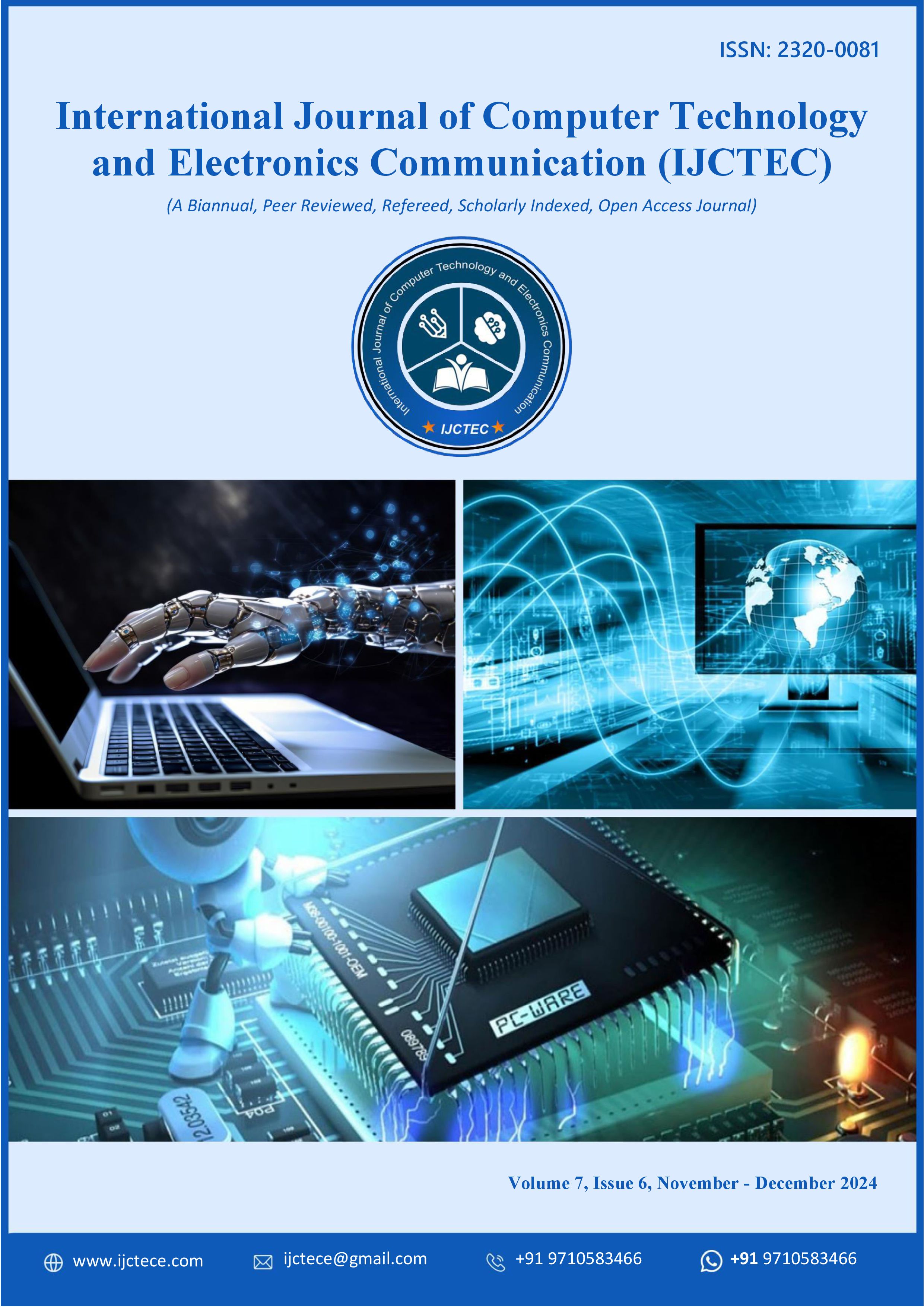Energy-Efficient and Privacy-Aware AI Framework for Smart Pediatric Hospitals: Integrating DC–DC Converter Design with Secure NLP-Based Decision Systems
DOI:
https://doi.org/10.15680/IJCTECE.2024.0706007Keywords:
Energy-efficient hardware, DC–DC converters, edge AI, clinical natural language processing, federated learning, differential privacy, pediatric hospitals, power–software co-design, low-power medical devices, explainable AIAbstract
Smart pediatric hospitals combine pervasive sensing, edge compute, and AI-driven clinical decision support to improve care delivery, but they must balance energy constraints (battery-powered devices, local edge nodes), safety/regulatory requirements, and strict privacy for children’s health data. We propose an integrated framework that connects energy-aware DC–DC converter and power-management design at the hardware layer with a privacy-preserving, NLP-based decision stack at the software layer. At hardware level, modern low-voltage, high-efficiency non-isolated and integrated DC–DC converters (buck converters, charge pumps, on-chip regulators) and adaptive power-management policies minimize energy per inference for edge AI modules embedded in bedside monitors and mobile clinician devices. At system level, on-device and federated NLP models extract clinical signals from unstructured notes, nursing logs, device alerts and parental messages; model updates are coordinated with secure aggregation and differential-privacy mechanisms to avoid raw-data sharing and limit leakage. Energy-aware ML strategies (model sparsity, mixed precision, conditional compute), combined with hardware power states and converter-level energy scaling, reduce operational energy while preserving clinical utility. The framework includes (a) co-design guidelines — mapping workload profiles to converter operating points and power modes; (b) a privacy and governance stack (local de-identification, federated learning orchestration, DP budgets, secure aggregation); and (c) operational policies for safe automation of NLP-driven alerts and clinician-in-the-loop escalation. We outline an evaluation plan using lab bench measurements (converter efficiency curves, end-to-end energy per inference), retrospective EHR/NLP backtests for accuracy and privacy leakage analysis, and prospective pilot deployments in pediatric wards. We discuss trade-offs: tighter privacy budgets increase noise and can harm downstream sensitivity, and extreme energy minimization may reduce model capacity — both require careful co-optimization and human-centered governance. The proposed architecture enables resilient, low-energy, privacy-aware AI for pediatric hospitals while preserving clinician oversight and regulatory compliance.
References
1. Dwork, C., & Roth, A. (2014). The algorithmic foundations of differential privacy. Foundations and Trends® in Theoretical Computer Science, 9(3–4), 211–407.
2. Abadi, M., Chu, A., Goodfellow, I., McMahan, H. B., Mironov, I., Talwar, K., & Zhang, L. (2016). Deep learning with differential privacy. Proceedings of the 2016 ACM SIGSAC Conference on Computer and Communications Security.
3. Sangannagari, S. R. (2023). Smart Roofing Decisions: An AI-Based Recommender System Integrated into RoofNav. International Journal of Humanities and Information Technology, 5(02), 8-16.
4. Kairouz, P., McMahan, H. B., Avent, B., Bellet, A., Bennis, M., Bhagoji, A. N., … Yu, F. X. (2021). Advances and open problems in federated learning. Foundations and Trends® in Machine Learning, 14(1–2), 1–210.
5. MDPI. (2021). Low-Voltage DC-DC Converter for IoT and On-Chip Energy Management. Sensors, 21(17), 5721. MDPI
6. Gonepally, S., Amuda, K. K., Kumbum, P. K., Adari, V. K., & Chunduru, V. K. (2023). Addressing supply chain administration challenges in the construction industry: A TOPSIS-based evaluation approach. Data Analytics and Artificial Intelligence, 3(1), 152–164.
7. WJARR. (2023). High-efficiency DC-DC converters for IoT applications (technical report). Wjarr
8. Narapareddy, V. S. R. (2022). Strategies for Integrating Services with External Systems Via Rest & Soap. Universal Library of Engineering Technology, (Issue).
9. Li, X., Zhou, Z., & Zhang, Y. (2023). A review of fully integrated and embedded power converters for IoT. (Conference/Journal overview). ResearchGate
10. Kumbum, P. K., Adari, V. K., Chunduru, V. K., Gonepally, S., & Amuda, K. K. (2023). Navigating digital privacy and security effects on student financial behavior, academic performance, and well-being. Data Analytics and Artificial Intelligence, 3(2), 235–246.
11. Qin, J., et al. (2023). A survey: Edge AI — energy, architectures, and efficient models. ScienceDirect / Edge AI survey (review). ScienceDirect
12. Konda, S. K. (2022). Strategic execution of system-wide BMS upgrades in pediatric healthcare environments. Journal of Advanced Research in Engineering and Technology, 1(2), 27–38. https://doi.org/10.34218/JARET_01_02_003.
13. ArXiv Authors. (2023). Green Edge AI: A contemporary survey. arXiv preprint. arXiv
14. Li, T., Sahu, A. K., Talwalkar, A., & Smith, V. (2019). Federated learning: Challenges, methods, and future directions. arXiv:1908.07873.
15. MDPI. (2023). A review of federated learning architectures for privacy-preserving applications. Electronics (review). MDPI
16. Pimpale, S. (2023). Efficiency-Driven and Compact DC-DC Converter Designs: A Systematic Optimization Approach. International Journal of Research Science and Management, 10(1), 1-18.
17. Sankar,, T., Venkata Ramana Reddy, B., & Balamuralikrishnan, A. (2023). AI-Optimized Hyperscale Data Centers: Meeting the Rising Demands of Generative AI Workloads. In International Journal of Trend in Scientific Research and Development (Vol. 7, Number 1, pp. 1504–1514). IJTSRD. https://doi.org/10.5281/zenodo.15762325
18. G Jaikrishna, Sugumar Rajendran, Cost-effective privacy preserving of intermediate data using group search optimisation algorithm, International Journal of Business Information Systems, Volume 35, Issue 2, September 2020, pp.132-151.
19. Lanka, S. (2023). Built for the Future How Citrix Reinvented Security Monitoring with Analytics. International Journal of Humanities and Information Technology, 5(02), 26-33.
20. Mesnil, G., et al. (2021). Natural language processing systems for extracting information from electronic health records: systematic review and open challenges. JAMIA Open / related reviews. OUP Academic
21. Sharma, A., et al. (2022). Clinical NLP and CDSS: Systematic reviews and pathways to deployment. BMC Medical Informatics and Decision Making / surveys through 2023. BioMed Central
22. JAMA Network. (2022). Natural language processing of electronic health records to measure clinical trial outcomes: diagnostic study (example of deployed clinical NLP). JAMA Network
23. MDPI. (2022). XAI-based clinical decision support systems: a systematic review (applications and explainability in clinical contexts).


